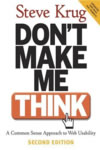Don't Make Me Think
by Steve Krug
Krug's central point is, essentially, the argument for scrupulous copy editing; by removing every distraction from the reader's path, we have done everything in our power to respect the reader's time and to facilitate understanding.
It is difficult (but necessary) to argue with the common sense of this proposition. It is true that saving unnecessary steps, avoiding unintentional ambiguity, and omitting needless words will make a web page a little more clear and might prevent some misunderstandings. The result, all things being equal, might be a few extra sales and a little extra good will.
But all things are not equal, and Krug's underlying premise -- that Web users prefer not to think about what they're seeing or doing, that they don't want to read or reflect -- is simply mistaken. People love to read Web pages. They do it every day. The growth of weblogs is driven completely by reading: most web logs are nearly pure text. Some of the most widely-read blogs use off-the-rack page designs. Others use designs chosen for the extreme ugliness: Matt Drudge's influence, surely, is unconnected with design.
In any case, the goal of a Web site must ultimately be, quite simply, to make people think. Even simple sales sites aspire not simply to gain an order, but rather to gain a customer -- and to change the customer so they'll become an even better customer.
The Bauhaus Manifesto claimed that
Das Endziel aller bildnerischen Tätigkeit ist der Bau!
The ultimate aim of all creative activity is the building!
Gropius was an architect and the Bauhaus was working to reintegrate fine art, the building crafts, and engineering in an era of brick and glass. We no longer work exclusively in physical media; making stuff is no longer what artists necessarily do, and reintegrating art and science -- putting graphic design and code and software and writing and photography and management together -- is closer to the spirit of the age than designing better factories and kitchens.
The ultimate aim of all creative activity is now the website, and the aspiration of a website is simply the aspiration of all art: to make us think.
Update: reaction from Johndan Johnson-Eilola.
